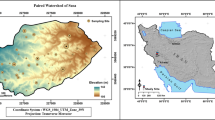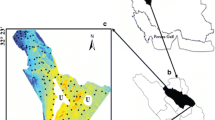Abstract
Local morphometric variables (LMVs) are frequently found as weaker predictors than other environmental covariates in digital soil mapping. This study tested and evaluated the performance of a hybrid approach combining gradient boosted regression trees (GBRT) and regularized regression (RR) algorithms in predicting soil textural fractions using a set of LMVs in Khuzestan province, Iran. Here five LMVs (slope gradient, slope aspect, horizontal curvature, vertical curvature, and contour geodesic torsion) were derived from a spheroidal equal-angular DEM as original predictors. The results demonstrated that the hybrid approach improved prediction accuracy for sand, clay, and silt contents by an average of 56% compared to the GBRT models. The importance analysis revealed the significant contribution of tree-based variables obtained from decomposing GBRT models in predicting soil textural fractions. This approach could be recommended for digital soil mapping, particularly in situations of limited environmental covariates or geomorphometric techniques that cannot be easily applied.





Similar content being viewed by others
Data Availability
Data will be made available on request.
References
Lal, R.; Shukla, M.K.: Principles of Soil Physics (1st ed.). CRC Press (2004). https://doi.org/10.4324/9780203021231
Stępień, M.; Samborski, S.; Gozdowski, D.; Dobers, E.S.; Chormański, J.; Szatyłowicz, J.: Assessment of soil texture class on agricultural fields using ECa, Amber NDVI, and topographic properties. J. Plant Nutr. Soil Sci. 178(3), 523–536 (2015). https://doi.org/10.1002/jpln.201400570
Amirian Chekan, A.; Taghizadeh Mehrjerdi, R.; Sarmadian, F.; Heidary, A.: Three-dimensional mapping of soil texture using spline depth functions and artificial neural networks. Iran. J. Soil Water Res. 48(1), 113–123 (2017). https://doi.org/10.22059/ijswr.2017.61346
Dharumarajan, S.; Hegde, R.: Digital mapping of soil texture classes using random forest classification algorithm. Soil Use Manag. 38(1), 135–149 (2022). https://doi.org/10.1111/sum.12668
Florinsky, I.: Digital Terrain Analysis in Soil Science and Geology, 2nd edn. Academic Press, Amsterdam (2016)
Khanifar, J.; Khademalrasoul, A.: Multiscale computation of different plan curvature forms to enhance the prediction of soil properties in a low-relief watershed. Acta Geophys. (2023). https://doi.org/10.1007/s11600-022-01013-0
Khanifar, J.: Modeling of soil thickness based on DEM derivatives calculated using different polynomials. Arab. J. Geosci. 15(7), 655 (2022). https://doi.org/10.1007/s12517-022-09941-3
Khanifar, J.; Khademalrasoul, A.: Modeling of land surface temperature–multiscale curvatures relationship using XGBoost algorithm (Case study: Southwestern Iran). Int. J. Environ. Sci. Technol. 19(12), 11763–11774 (2022). https://doi.org/10.1007/s13762-022-04409-z
Young, M.: Statistical characterization of altitude matrices by computer. Terrain analysis: program documentation: Report 5 on Grant DA-ERO-591-73-G0040. Department of Geography, University of Durham, Durham, UK. 18 pp (1978).
Evans, I. S.: Statistical characterization of altitude matrices by computer. An integrated system of terrain analysis and slope mapping. The final report on grant DA-ERO-591-73-G0040. Durham, UK: University of Durham (1979).
Zevenbergen, L.W.; Thorne, C.R.: Quantitative analysis of land surface topography. Earth Surf. Proc. Landf. 12(1), 47–56 (1987). https://doi.org/10.1002/esp.3290120107
Shary, P.A.: Land surface in gravity points classification by a complete system of curvatures. Math. Geol. 27, 373–390 (1995). https://doi.org/10.1007/BF02084608
Khanifar, J.; Khademalrasoul, A.: Effects of neighborhood analysis window forms and derivative algorithms on the soil aggregate stability–Landscape modeling. CATENA 198, 105071 (2021). https://doi.org/10.1016/j.catena.2020.105071
Keshavarzi, A.; del Árbol, M.Á.S.; Kaya, F.; Gyasi-Agyei, Y.; Rodrigo-Comino, J.: Digital mapping of soil texture classes for efficient land management in the Piedmont plain of Iran. Soil Use Manag. 38(4), 1705–1735 (2022). https://doi.org/10.1111/sum.12833
Mirzaeitalarposhti, R.; Shafizadeh-Moghadam, H.; Taghizadeh-Mehrjardi, R.; Demyan, M.S.: Digital soil texture mapping and spatial transferability of machine learning models using sentinel-1, sentinel-2, and terrain-derived covariates. Remote Sens. 14(23), 5909 (2022). https://doi.org/10.3390/rs14235909
Sahraei, N.; Landi, A.; Hojati, S.: Digital mapping of soil texture components in part of Khuzestan plain lands using machine learning models. Iran. J. Soil Water Res. 53(10), 2261–2276 (2022). https://doi.org/10.22059/ijswr.2022.348442.669360 [Persian literature]
Song, X.; Liu, F.; Zhang, G.; Li, D.; Zhao, Y.; Yang, J.: Mapping soil organic carbon using local terrain attributes: a comparison of different polynomial models. Pedosphere 27(4), 681–693 (2017). https://doi.org/10.1016/S1002-0160(17)60445-4
Khanifar, J.; Khademalrasoul, A.: Utilization of multi-scale geomorphometric algorithms and third-order morphometric variables for soil thickness modeling. T GIS. 26(2), 887–901 (2022). https://doi.org/10.1111/tgis.12891
Florinsky, I.V.: Derivation of topographic variables from a digital elevation model given by a spheroidal trapezoidal grid. Int. J. Geogr. Inf. Sci. 12(8), 829–852 (1998). https://doi.org/10.1080/136588198241527
Riza, S.; Sekine, M.; Kanno, A.; Yamamoto, K.; Imai, T.; Higuchi, T.: Modeling soil landscapes and soil textures using hyperscale terrain attributes. Geoderma 402, 115177 (2021). https://doi.org/10.1016/j.geoderma.2021.115177
Ivanov, A., Gocheva-Ilieva, S., Stoimenova, M.: Hybrid boosted trees and regularized regression for studying ground ozone and PM10 concentrations. In AIP Conference Proceedings (vol. 2302 No. 1, p 060005). AIP Publishing (2020). https://doi.org/10.1063/5.0033591
Batjes, N.H.; Ribeiro, E.; van Oostrum, A.J.M.: Standardised soil profile data for the world (WoSIS snapshot—September 2019). Earth Syst. Sci. Data (2020). https://doi.org/10.17027/isric-wdcsoils.20190901
Moeys, J.: The soil texture wizard: R functions for plotting, classifying, transforming and exploring soil texture data. R package soiltexture, Version 1.5.1 (2018). Available online: https://cran.r-project.org/web/packages/soiltexture/vignettes/soiltexture_vignette.pdf (Accessed on 01 July 2023).
Khanifar, J.; Khademalrasoul, A.: Effect of neighborhood size on morphometric variables and their relationship with vegetation cover within three geomorphologically and climatically different sub-watersheds in Southwest Iran. Iran. J. Soil Water Res. 53(1), 1–13 (2022). https://doi.org/10.22059/ijswr.2022.334244.669136[Persianliterature]
Minár, J.; Evans, I.S.; Jenčo, M.: A comprehensive system of definitions of land surface (topographic) curvatures, with implications for their application in geoscience modelling and prediction. Earth-Sci. Rev. 211, 103414 (2020). https://doi.org/10.1016/j.earscirev.2020.103414
Abdi, O.; Uusitalo, J.; Pietarinen, J.; Lajunen, A.: Evaluation of forest features determining GNSS positioning accuracy of a novel low-cost, mobile RTK system using LiDAR and TreeNet. Remote Sens. 14(12), 2856 (2022). https://doi.org/10.3390/rs14122856
Salford Systems.: Salford Predictive Modeler: Model Compression via ISLE and RuleLearner® (2019). Available online: https://www.minitab.com/enus/products/spm/user-guides/ (Accessed on 31 Oct 2022).
Chatrenor, M.; Landi, A.; Farrokhian Firouzi, A.; Noroozi, A.; Bahrami, H.: Spectral behavior modeling of soil texture over dust center of Khuzestan province using hyperspectral images and random forest model. Adv. Appl. Geol. 9(4), 466–479 (2020). https://doi.org/10.22055/aag.2019.29642.1990 [Persian literature]
Khanifar, J.; Khademalrasoul, A.; Amerikhah, H.: Effects of digital elevation model (DEM) spatial resolution on soil landscape analysis (Case study Raakat watershed of Izeh, Khuzestan Province). Appl. Soil Res. 8(1), 121–135 (2020) [Persian literature]
Roecker, S. M. Thompson, J. A.: Scale effects on terrain attribute calculation and their use as environmental covariates for digital soil mapping. In: Boettinger, J. L., Howell, D. W., Moore, A. C., Hartemink, A. E., Kienast-Brown, S. (Eds.) Digital soil mapping: Bridging research, environmental application, and operation, pp. 55–66. Springer, Dordrecht (2010). https://doi.org/10.1007/978-90-481-8863-5_5
Fathololoumi, S.; Vaezi, A.R.; Alavipanah, S.K.; Ghorbani, A.; Saurette, D.; Biswas, A.: Improved digital soil mapping with multitemporal remotely sensed satellite data fusion: a case study in Iran. Sci. Total. Environ. 721, 137703 (2020). https://doi.org/10.1016/j.scitotenv.2020.137703
Taghizadeh-Mehrjardi, R.; Hamzehpour, N.; Hassanzadeh, M.; Heung, B.; Goydaragh, M.G.; Schmidt, K.; Scholten, T.: Enhancing the accuracy of machine learning models using the super learner technique in digital soil mapping. Geoderma 399, 115108 (2021). https://doi.org/10.1016/j.geoderma.2021.115108
Naimi, S.; Ayoubi, S.; Demattê, J.A.; Zeraatpisheh, M.; Amorim, M.T.A.; Mello, F.A.D.O.: Spatial prediction of soil surface properties in an arid region using synthetic soil image and machine learning. Geocarto Int. 37(25), 8230–8253 (2022). https://doi.org/10.1080/10106049.2021.1996639
Taghizadeh-Mehrjardi, R.; Schmidt, K.; Toomanian, N.; Heung, B.; Behrens, T.; Mosavi, A.; Scholten, T.: Improving the spatial prediction of soil salinity in arid regions using wavelet transformation and support vector regression models. Geoderma 383, 114793 (2021). https://doi.org/10.1016/j.geoderma.2020.114793
Behrens, T.; Schmidt, K.; Ramirez-Lopez, L.; Gallant, J.; Zhu, A.X.; Scholten, T.: Hyper-scale digital soil mapping and soil formation analysis. Geoderma 213, 578–588 (2014). https://doi.org/10.1016/j.geoderma.2013.07.031
Savari, Z.; Hojati, S.; Taghizadeh Mehrjerdi, R.: Digital mapping of surface soil salinity in Khuzestan Province, using regression kriging. JWSS-Isfahan Univ. Technol. 25(3), 159–175 (2021). https://doi.org/10.47176/jwss.25.3.24654 [Persian literature]
Acknowledgements
The author would like to sincerely gratitude his father and mother for their full support throughout this research. The author is also very grateful to all individuals who contributed to the datasets utilized in this study.
Funding
No funding was received for conducting this study.
Author information
Authors and Affiliations
Corresponding author
Ethics declarations
Conflict of interest
The author declares no competing interests.
Rights and permissions
Springer Nature or its licensor (e.g. a society or other partner) holds exclusive rights to this article under a publishing agreement with the author(s) or other rightsholder(s); author self-archiving of the accepted manuscript version of this article is solely governed by the terms of such publishing agreement and applicable law.
About this article
Cite this article
Khanifar, J. Mapping Soil Textural Fractions at Regional Scale Based on Local Morphometric Variables Using a Hybrid Approach (Case Study: Khuzestan Province, Iran). Arab J Sci Eng (2024). https://doi.org/10.1007/s13369-024-08961-3
Received:
Accepted:
Published:
DOI: https://doi.org/10.1007/s13369-024-08961-3




